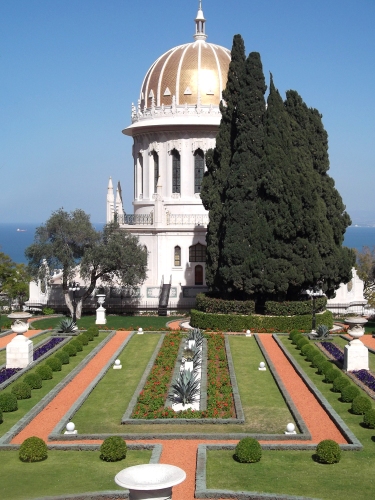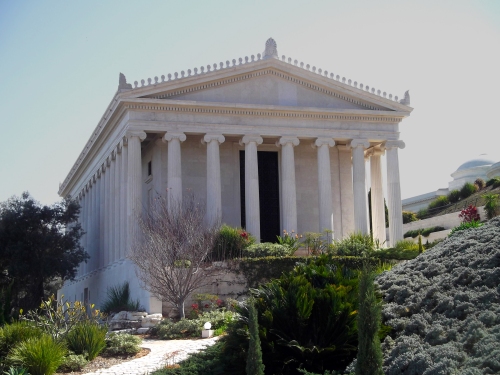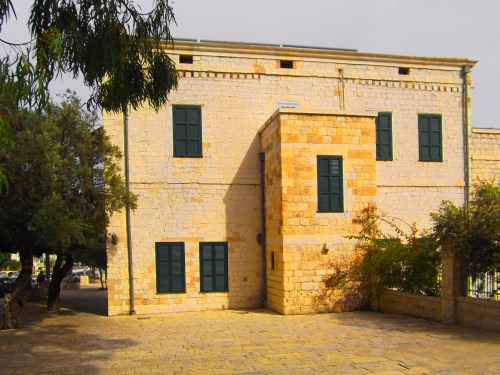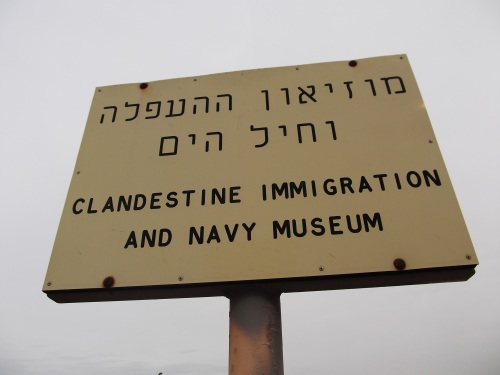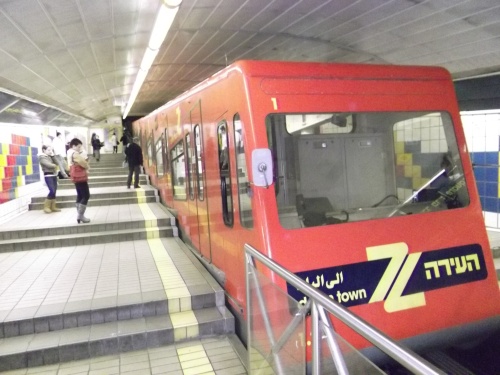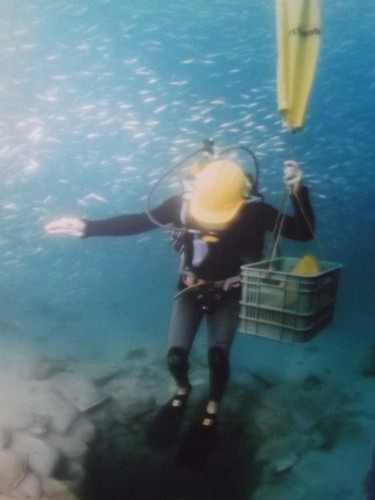On Monday I went, once again, to Haifa for my Tourist Israel gig. I had two big destinations, the Bahai Gardens and Madatech National Science, Technology and Space Museum. I had to drop off a letter at the City Museum so I made my way towards the gardens going up the German Colony. I feel like I know that particular area of Haifa better now that I may never get lost there again – getting lost can have its upside… Anyhow, I found a hapless pilgrim of the Bahai faith and mercilessly interrogated him on the bus routes to the main gate where the Bahai Gardens’ official tours are given. He gave me what I needed and I released him. I waited at the bus stop for what seemed to be an eternity, constantly checking the time because the last tour is at 12 o’clock noon and it was already 11 something.
At last the bus pulled up and I climbed aboard. I settled down and noticed a couple holding an English Haifa city map so I asked them if they were tourists. She was, he wasn’t. They told me that they too were headed to the Bahai Gardens to I told them that I’d tag along. On the bus the young woman, a Brazilian visiting Israel with an Israeli male companion, decided she’d have a little snack. She took out a nut with shell intact (not sure what type of nut it was but it had a pretty tough shell) and placed it on the floor of the bus, then she stepped on it. The crunch was loud and her male friend look horrified as everybody watched her messy up the floor with shards of shell and crumbs of nutmeat. She later resorted to manual cracking of the nut and was thus spared of any further embarrassments. When we reached the upper section of the gardens, where the free tours are given, we got off out bus and took pictures at the upper observation terrace. Turns out that when I was on the Louis Promenade some weeks back I was only several hundred feet from the Bahai Gardens’ main gate. Here is a panoramic picture I took of the bay and land down below (click to see it enlarged):
After the picture taking and the gazing-out-at-the-view-whilst-chatting, we headed over to the tour group gathering area and were signed up and checked for weaponry. I was included in the young lady’s party so the guides think I am from Brazil and the couple thinks I am an undercover journalist – whatever! We started the copious walking that is the tour while stopping every once in a while to listen to the guide tell us about the Bahais and the gardens that was built on the land bought by the early Bahai followers. Today there is an amazing 7 million Bahais and they aren’t even allowed to live in Israel, their holiest place on Earth. The good thing about the Bahai is that they are respectful of the wishes of Israel, knowing that Israel doesn’t allow missionaries and thereby forbidding it amongst themselves. That’s a kind gesture in the world we live in today. Anyway, on the tour we passed by the large and impressive structure that is the Bahai Archives Library, I was wondering what these buildings were when looking down at them from the Louis Promenade – now, thanks to the tour guide, I know.
After the 45 minute walking tour there was a 20 minute video offered but I declined. I had to leave my new friends behind as they stayed for the video. I then exited the gardens, following the guards directions, boarded a bus and got off near my next destination: the Madatech National Science, Technology and Space Museum.
The Madatech building is what used to be the old Technion building, built sometime in the 1910s. Even Albert Einstein came to visit back in 1923 and planted a palm tree which is still outside the building to this day. In the 80s the museum was established in the building and it is a magnificent structure. However, once inside, I was a bit puzzled about the Madatech Museum. The bottom floor exhibitions, just beside the front desk, seemed lonely and small. I couldn’t help but wonder why the admission fee was so steep (75 shekel for adults – but just 10 shekels for olim chadashim within their first year in Israel) for such a museum. However, when I continued on up to the first floor I was pleasantly surprised to find much, much better exhibits. One of my favourite on the first floor has got to be the Einstein Hall (Ilan Ramon Exhibition) where personal belongings of Ilan Ramon, Israel’s first astronaut, were found after the tragic disaster of the Columbia space shuttle back in 2003. Included in the finding were CDs given to him by local Israeli artists, remnants of his Israeli Air Force flag, a page of his diary which miraculously survived and other small items. Another notable room on the first floor is the Green Energy exhibition where pressing buttons turns on solar power, wind power and water power, each activating its perspective energy source and illuminating small lights to show how the power is generated. The second floor was even better with exhibits such as Magical Science – scientific breakdown of classic magical tricks (yes, I enjoyed having my weight distributed on a bed of nails), the Optical Illusions room and the Aviation Hall. Here is part of the Aviation Hall:
The Dark Room was also of particular interest to me because I found the phosphorescent wall and the plasma ball to be exquisitely entertaining. And of course, who can resist the mirrors in the Mirrors Hall? After some two hours spent inside I found out that there was an outdoor area as well. I had not been mentally prepared for this museum’s enormity as I thought it was supposed to be “not as big as one would hope.” Needless to say, it was plenty big for me. Once I’d made my way to the outside Noble Energy Science Park I found several interesting items. One was a retired Israeli Air Force F-21 Kfir warplane, another was a helicopter-like creation that requires pedaling and pumping to “take flight.” I was a tad too large to comfortably pedal – my knees were trying to crush my rib-cage. But shortly I was assisted by a worker of the museum who showed me his “flying” skills and then led me to the next activity. This one was called the Boyo – a human yo-yo – and he showed me how to hold on, pull while dropping to one knee, stand up and let the recoil of the rope pull one up. I attempted to reach the 4 metre (13 feet) launch but I wasn’t experienced and I landed on an angle, losing the necessary force to reach the top. I tried over and over and he tried helping me but my arms got kinda sore so I gave up.
The museum guy also took me to another of Madatech’s features, the Sports Science building with all sorts of energy-sapping activities to be experienced. There I karate-chopped a foam block measuring the speed of my chop. I got 90-something kilometres per hour but I’m guessing I could have gotten more but my arms were a tad sore from the Boyo bouncing. I also raced wheelchairs but the empty seat beside me put no effort into the race so I stopped racing and relaxed instead. When I was done in the Sports Science building I realised that I was at Madatech for nearly 3 hours and wondered why there wasn’t anywhere to nap… After leaving I meandered around the area, dropped some change into a street musician’s case as he broke out into a oldies (1920s-40s) tune – putting a skip in my step, and then boarded a bus to the Cinemall where I got a falafel and a train to Nahariya. At Nahariya I hopped on a bus and arrived home. To Haifa again next time, or elsewhere?
(Thanks again to Boruch Len of Legacy Photography for Adobe CS5 picture touch-ups!)
